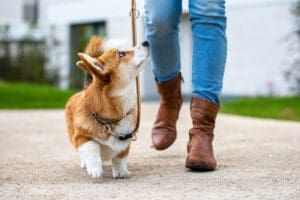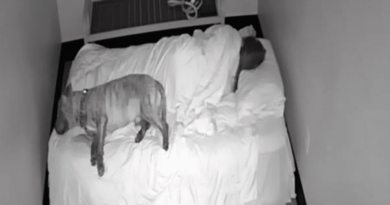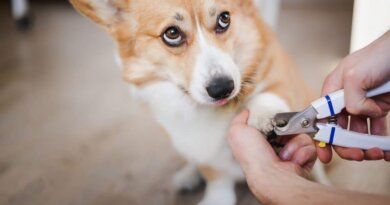How to Improve Your Dog’s Leash Manners
I occasionally teach a “leash manners” class at my friend’s dog-training center. The clients who sign up for this class do so because they are having trouble with their dogs on leash. Most of the dogs pull, some are somewhat reactive to other dogs when they are on leash, and some weave back and forth and run circles around their handlers and stop whenever they want to sniff or urine-mark. All the owners are frustrated with their dogs; that’s why they sign up for this class!
I start Week One with getting the owners to pay attention to how they hold their dogs’ leashes, what cues they give their dogs, and how they reinforce the behaviors they like – those moments where the dogs are walking nicely at their sides on a loose leash. In this first class, their hands are all over the place, they give absolutely no cues (unless you consider “NO! NO! STOP it!” a cue), and the reinforcements are grudging at best – mostly because they are so irritated with their dogs that they don’t want to reinforce them for anything!
I almost always see a tiny amount of improvement in the Week Two class. The students are handling their leashes better, they sometimes use cues for “Let’s walk!” – and the dogs now realize that there is something in it for them; if they pay a modicum of attention to their handlers and they “check in” with their handlers occasionally, they can grab a treat. But these improvements are fleeting.
So this is when I give my speech about practicing. Training your dog to walk nicely on leash is a physical skill – and no physical skill gets better unless you practice it properly. No golf swing, no tennis serve, no skateboard trick, no piano playing – improves unless you practice the proper movements. And since dogs are essentially body-language experts, if we are giving them no signals or mixed signals, a mishmash of physical punishments and random reinforcements, our dogs decide we are not making sense and they tune us out as irrelevant. We have to be consistent, I tell them; we have to consistently ask them for the behaviors we want, consistently reinforce those behaviors, and consistently prevent the behaviors we don’t want. It takes practice, but if they practice with these goals foremost in mind, they will get it.
In this class, I also show them some new things, such as “emergency U-turns.” We can use these when we see something up ahead that’s sure to make our dogs go “over threshold,” tossing them into the deep end of the behavioral pool with only little floaties on. We turn this into a fun, engaging game that re-connects the dog and handler nicely. But mostly we practice: giving cues, offering reinforcement for the behavior we like, and managing the leash to prevent behavior we don’t want, without punishing jerks and yanks!
I can tell when they aren’t practicing. They often come back in Week Three and are doing about the same as (or perhaps worse than) they looked in Week Two. What happened?
My theory is that, after two classes, they discovered that there are no miracles. They aren’t going to learn some revolutionary thing they didn’t already know, some new trick that will transform their dog into an obedience champion overnight. Their dog is still pulling and they are still frustrated – so much so, that they haven’t hardly taken the dog out at all.
This is where the rubber meets the road. This is where I offer to show them, with their dog, how their dog can walk nicely on leash if their hands are quiet and consistent – firmly resisting the dog’s pulling without changing the leash length, neither allowing the dog to bungee-cord forward nor strong-arming them backward. Their dog will “buy in” to learning a new style of walking together if they use a high rate of reinforcement and give almost constant feedback to the dog, so the dog understands that there is a nice conversation to be had when out walking together, not just shouting brief dispatches to each other across the expanse of the length of the leash.
Every so often, an owner seems happy to see that their dog can walk so nicely, but I’d say that the majority of time, they look a little mad. “Why will he do it for you, and not me?!” they want to know.
Because I have practiced, I tell them. I’ve done my 10,000 hours of walking with dogs on leash. I am not babbling in body language, nor refusing to speak: I am communicating consistently in super simple terms they can grasp within moments. You have to practice your language skills – your body language – and have someone watch and tell you when your hands are crazy, or you are checking out of the conversation and absentmindedly letting your dog drag you to that bush to smell. Video yourselves! I tell them. Dedicate even just a few minutes a couple times a day, every day, and you guys are going to get this!
And you know what? Almost always, in the Week Four class, they are looking pretty darn good together – or at least, way better. Their dogs now have a semblance of understanding what their owners want; they are starting to speak the same language. There are longer and longer minutes of “conversation” and sparks of happiness start to fly between them.
You have to practice!





